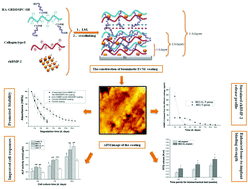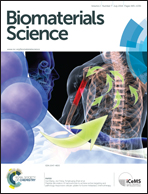Biomimetic ECM coatings for controlled release of rhBMP-2: construction and biological evaluation†
Abstract
As we all know biochemical surface modification is promising for implantable biomedical device applications due to its ability to directly provide therapeutic molecular cues for tissue repair. However, presenting multiple molecular cues on implant surfaces in the proper way is challenging. In this study, a multi-component polyelectrolyte multilayer (PEM) coating composed of collagen type I, RGD peptide functionalized hyaluronic acid, and recombined human BMP-2 (rhBMP-2) was constructed on Ti via a layer by layer technique. Subsequently, this coating was crosslinked via disulfide bonds to form a surface gel coating with a semi-interpenetrating network. A disulfide-crosslinked RGD-containing biomimetic extracellular matrix coating that could serve as a reservoir for rhBMP-2 was thus obtained. The embedded rhBMP-2 displayed a sustained release profile and a strong resistance to the physiological environment. In vitro biological evaluation revealed that the resultant disulfide crosslinking bioactive coating could effectively modulate cellular behaviors of pre-osteoblasts such as adhesion, proliferation and differentiation. In vivo study further revealed that this coating could enhance the bone-to-implant integration characterized by the increased removal torque values.


 Please wait while we load your content...
Please wait while we load your content...